Ents,
While visiting relative in Savannah, Georgia, I followed a
recommendation from Will Fell and visited the Webb Wildlife
Center.
The center stands on the South Carolina side of the Savannah
about
thirty miles inland from the coast. A mosaic of maintained
fields and
forests occupy most of land surrounding the Department of
Natural
Resources run facility. Permanent hunting blinds help hunters
take
advantage of the center's management, but the center also
encourages
some non-game species, including the endangered red-cockaded
woodpecker. The woodpeckers only nest in moderately large pines
with
rotten centers, a much-diminished resource in the southeast, but
labeled nest trees grow scattered throughout the center's pine
forest.
The open pine forests occupy much of the upland sites at the
property, but mixed hardwood forests remain in some areas.
Loblolly
pines and longleaf pines comprise most of the stands, but
shortleaf
pine, and according to online literature slash pine, grow
scattered
among them.
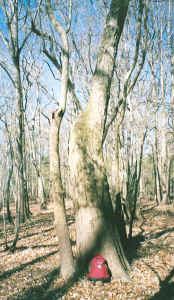
This water locust is a potential state
champion, and is 7'5" cbh, 64.4', with a maximum spread of 41'. The
tree grows about 50 yards from the possumhaw, green hawthorn, and
swamp dogwood.
A two-mile long trail provided me access to the extensive,
mature,
hardwood forest within the Savannah River floodplain. Even
though
elevations were only 25 to 30 feet, topographic features within
the
floodplain were surprisingly pronounced. Alternating, long,
linear
depressions and ridges, differing from each other by perhaps
five feet
elevation, made up most of the floodplain landscape.
Water tupelo and baldcypress rose out of the low areas,
sometimes
towering over a carolina ash and water elm (Planera aquatica)
midstory. Remnant cypresses, skipped over when the area was
logged,
are commonly throughout the floodplain. In particular, a grove
of
twisted old cypress in the deeper water at one end of an oxbow
lake
shows no evidence of logging. Many of the cypresses have large
buttresses, and exceed 20' cbh. The cypress knees grow in
proportion
to the swollen bases, and occasionally reach nine feet tall.
A mix of overcup oak; water hickory; sweetgum; laurel oak
(Quercus
laurifolia), a few American elms and baldcypress; and near the
river,
sycamore occupy the higher ground. The laurel oaks frequently
grow
along the interface between the two forest communities, but also
form
nearly pure stands on the higher ground. In winter, their dark,
verdant green canopies stand in high contrast to the surrounding
leafless canopy. Rivercane provides an alternative source of
winter
green in many floodplains, but at this site, the grass only
grows in
patches on higher ground near the river and in the upland
hardwood
forest adjacent to the floodplain, where the species becomes
thick.
Cherrybark oak and paw paw, also common floodplain denizens,
similarly
only grow in the adjacent hardwood forest. Instead on the higher
floodplain terrain, American hornbeam occupies the midstory with
some
possumhaw (Ilex deciduas) and young overcup oak and occasional
green
hawthorns.
Species Cbh Height
Baldcypress 25'11" 104.6'
Cottonwood, Swamp 8'7" 110.0'
Dogwood, Swamp 11" 25.1'
Hawthorn, Green 2'11" NA
Hawthorn, Green 2'11" 39.7'
Hawthorn, Green 3'7" 42.4'
Hawthorn, Green 3'3" 43.4'
Hickory, Water 11'5" 112.7'
Oak, Overcup 14'1" 93.9'
Oak, Overcup 8'10.5" 114.3'
Oak, Laurel 15'3" 90.1'
Oak, Laurel 17'11" 115.7'
Pine, Spruce 9'7" 104.8'
Pine, Spruce 7'3" 112.2'
Possumhaw 1'6.5" 43.0'
Possumhaw 1'11" 44.1'
Sweetgum 5'11" 121.9'
Sweetleaf 2'4" 47.2'
Sweetleaf 2'5" 47.6'
Sycamore 9'7" 130.0'
Waterelm 8'6" 58.4'
Waterlocust 7'5" 64.4'
Waterlocust 6'2" 75.5'
The baldcypress was large for the site, but certainly not the
largest
in the area. The tree was chosen for measurement largely because
it
was one of the few old cypress at the site not growing in
standing
water.
The swamp cottonwood approximates the sizes of the largest
individuals
in Congaree NP, and is a potential state champion.
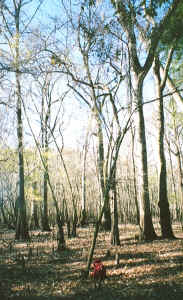
A potential national co-champion swamp
dogwood. 11" cbh and 25.1' tall with a maximum spread of 20.5'.
The swamp dogwood is a potential national co-champion, and is
only
0.7' shorter than the tallest ENTS has measured. The tree has
maximum
and minimum spreads of 20.5' and 13'.
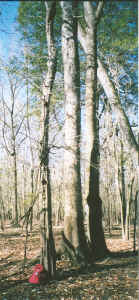
A 2'11" cbh, 39.7' tall, 28' maximum
spread Green Hawthorn. The tree is a potential South Carolina state
champion, and grows adjacent to the swamp dogwood and possumhaw.
The 39.7' green hawthorn has maximum and minimum spreads of 28
and
27'. All three far exceed the size of the current South Carolina
state champion.
Root flares consistently extended several feet up the laurel oak
trunks, but laurel oaks we still the largest hardwood species at
the
site. The laurel oak is a potential state champion exceeding the
points, but probably not the volume, of the current record
holder in
Congaree NP.
The spruce pines are the first ENTS has measured in South
Carolina.
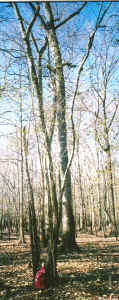
This 1'11" cbh x 44.1' possumhaw is
the second tallest ENTS has thus far documented.
The possumhaw essential ties the ENTS height record for the
species.
A much larger and equally tall tree, a former national champion,
grows
in Congaree NP.
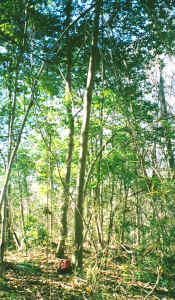
Two potential state champions
sweatleaf trees. The tree in the forground is 2'4" cbh and 47.2'
tall, and the tree in the bacground is 2'5" cbh and 47.6' tall.
The sweetleaf grow in colonies only on the natural levee by the
river.
Both tree are potential state champions and new height records.
The
taller tree has spreads of 14' and 26' while the shorter tree
has
spreads of 16.5' and 24'.
Sycamore appeared to be the tallest species at the site although
oaks
or pines in the upland areas may be taller. Most sycamores were
slightly shorter and much smaller in diameter than the
individual
measured.
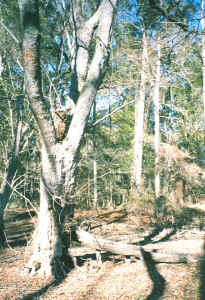
An 8'6" cbh x 58.4' water elm with
unusual stilt roots.
The water elm is a potential state champion, and the larger
diameter
individual has spreads of 40 and 41'.
Jess Riddle
|